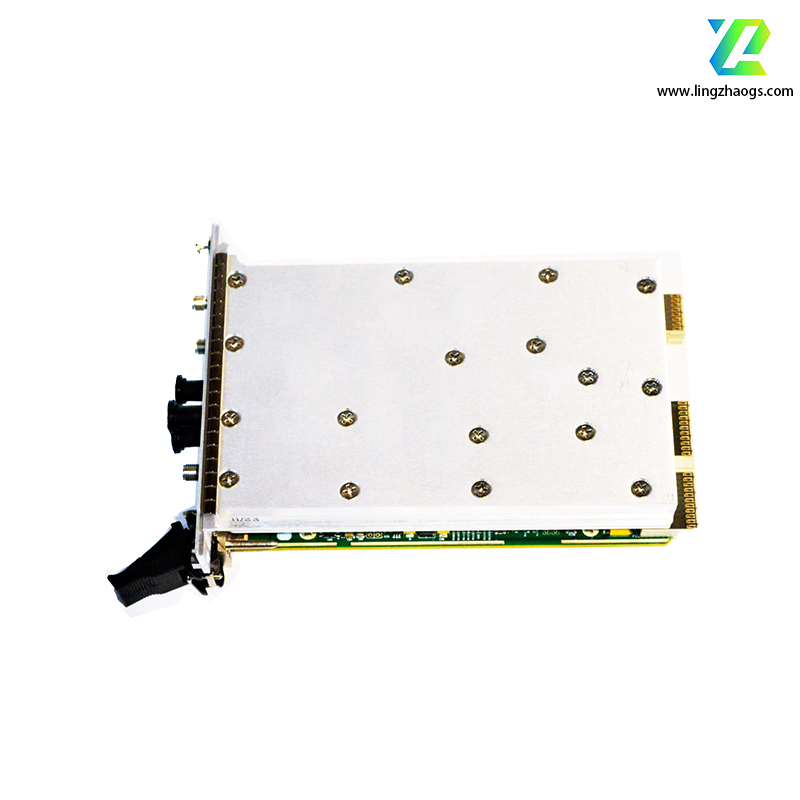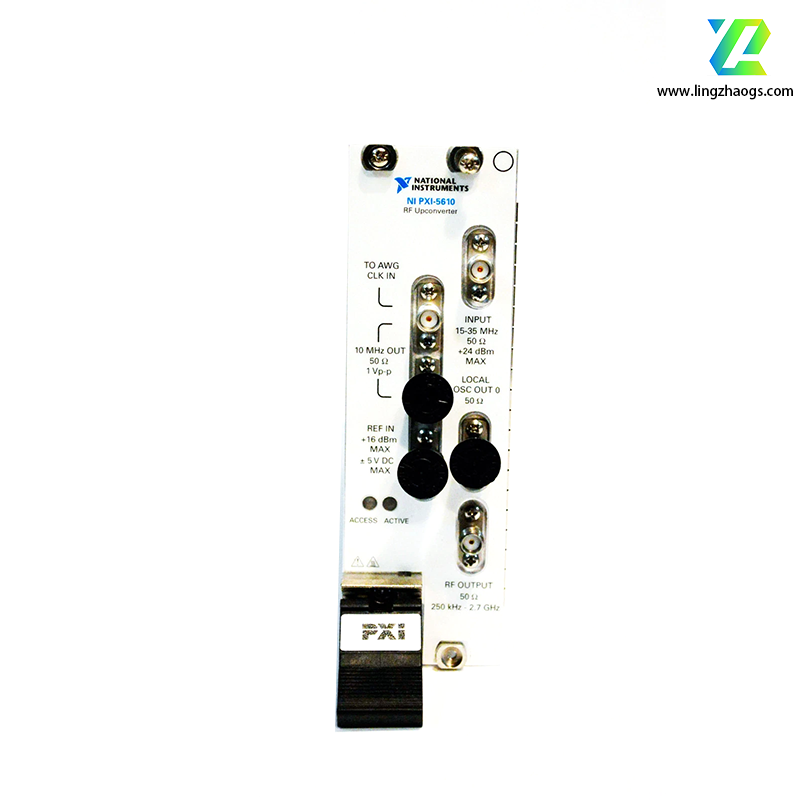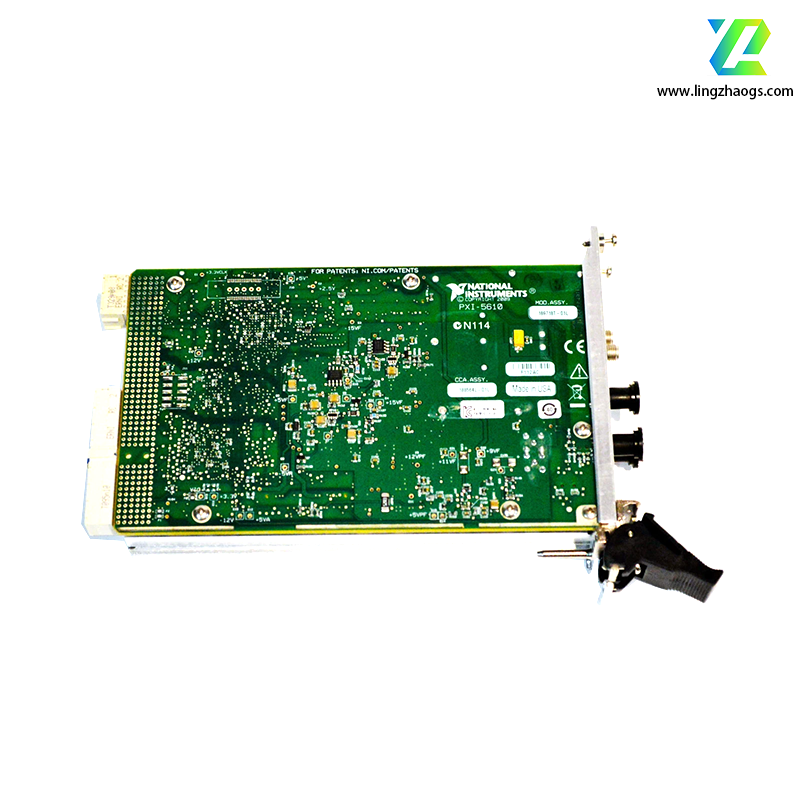The NI PXIe-5610 is a high-performance RF downconverter designed for the PXI Express (PXIe) bus architecture, belonging to National Instruments (NI)’s RF test product ecosystem. Its core function is to convert high-frequency RF signals to lower-frequency intermediate frequency (IF) signals—enabling PXIe digitizers or vector signal analyzers (VSAs) to extend their frequency coverage to 3 GHz. With excellent linearity, low noise, and seamless synchronization with other NI RF modules, it is ideal for aerospace/defense radar testing, wireless communication system validation, and high-frequency component characterization.
- Module Series: PXIe RF Downconverter, optimized for high-frequency signal frequency translation
- Part Number: 780574-01 (standard model)
- Physical Dimensions: 1-slot 3U PXIe form factor, 10.0 cm × 16.0 cm (width × length)
- Weight: Approximately 0.7 kg (1.54 lbs)
- Power Requirements:
- +3.3 V DC (1.2 A)
- +12 V DC (1.8 A)
- -12 V DC (0.4 A)
- Power consumption: Typical 22 W, Maximum 30 W
- Interface Type:
- PXIe x1 lane (for module control and synchronization, no data transfer)
- 2 SMA female connectors: 1 for RF input, 1 for IF output
- 1 SMA female connector for external local oscillator (LO) input
- 1 10-pin header for auxiliary trigger/synchronization signals (TTL-compatible)
- Operating Temperature Range: 0°C ~ 55°C (commercial grade)
- Environmental Ratings:
- Shock Resistance: 50 g peak (11 ms duration, half-sine)
- Vibration Resistance: 2 g RMS (10 Hz ~ 500 Hz, random)
- Ingress Protection: IP30 (prevents solid foreign object intrusion)
- Compliance: Meets FCC Part 15 Class A, CE EN 61326-1, UL 61010-1, and IEC 61010-1 safety & EMC standards
- RF Input Range: 10 MHz ~ 3 GHz (continuous coverage, no gaps)
- IF Output Range: 10 MHz ~ 1.5 GHz (programmable, user-selectable to match downstream digitizer/VSA bandwidth)
- LO Configuration:
- Internal LO: 10 MHz ~ 4.5 GHz (programmable, phase-locked to 10 MHz reference)
- External LO: 10 MHz ~ 4.5 GHz (input via SMA connector, for system-wide LO synchronization)
- LO Stability: ±0.1 ppm/year (internal LO, typical)
- Conversion Gain: 0 dB ±1 dB (typical, from RF input to IF output, at 1 GHz)
- LO Leakage: ≤-50 dBm (at RF input port, typical)
- Image Rejection: ≥50 dB (typical, with internal filtering)
- Linearity:
- Third-Order Intercept Point (IP3): +20 dBm (typical, at 1 GHz RF input)
- Second-Order Intercept Point (IP2): +45 dBm (typical, at 1 GHz RF input)
- Noise Performance:
- Noise Figure (NF): ≤8 dB (typical, at 1 GHz RF input, 1 MHz bandwidth)
- Output Noise Floor: ≤-150 dBm/Hz (typical, at IF output)
- Bandwidth & Filtering:
- RF Input Filter: Fixed low-pass filter (3 GHz cutoff) to reject out-of-band signals
- IF Output Filter: Programmable band-pass filter (10 MHz ~ 1.5 GHz) with selectable bandwidths (1 MHz, 10 MHz, 100 MHz, 1.5 GHz)
- Input/Output Impedance: 50 Ω (matched for all RF/IF ports, minimizes signal reflection)
- Input Power Handling:
- Maximum safe RF input power: +20 dBm (100 mW)
- Damage level: +30 dBm (1 W, 1 minute)
- Reference Clock:
- Internal: 100 MHz TCXO (Temperature-Compensated Crystal Oscillator), stability ±1 ppm/year
- External: 10 MHz reference input (via auxiliary header) for synchronization with PXIe chassis or external instruments
- Synchronization Features:
- Phase-locked to PXIe 10 MHz backplane clock, enabling multi-module phase coherence (e.g., multiple PXIe-5610s for MIMO testing)
- Trigger input/output via auxiliary header, supporting start/stop synchronization with downstream digitizers (e.g., NI PXIe-5186) or VSAs (e.g., NI PXIe-5632)
- Control Interface:
- Software-controlled via NI-RFSA driver (integrated with NI RFmx software suite)
- Programmable parameters: RF frequency, IF frequency, LO source, filter bandwidth, gain
- Recommended Software:
- NI RFmx Measurement Suite (required for integration with NI VSAs/digitizers and automated frequency conversion control)
- LabVIEW 2018+ (for custom test program development and system integration)
- NI TestStand (for test sequence automation and report generation)
- Drivers:
- NI-RFSA Driver (core driver for module control, frequency configuration, and synchronization setup)
- Compatible with NI-FGEN Driver (for LO synchronization with NI signal generators)
- Programming Compatibility:
- NI Ecosystem: Native support for LabVIEW, LabWindows/CVI, and Measurement Studio
- Third-Party Languages: Supports C/C++, C#, Python (via NI-RFSA Python bindings), and MATLAB (via NI-RFSA Toolbox)
- Integration with VSAs/Digitizers: Automatically recognized by NI PXIe-5632 (VSA) and NI PXIe-5186 (digitizer) for seamless frequency extension
- Calibration Tools:
- Built-in automated calibration (via NI RFmx) for gain flatness, phase linearity, and LO leakage correction
- Recommended calibration interval: 1 year (or after major temperature changes)
- External calibration support via NI Calibration Services (ISO 17025 accredited)
The NI PXIe-5610’s frequency extension capability makes it ideal for:
- Aerospace & Defense: Radar signal testing (1 ~ 3 GHz pulsed radar) by downconverting high-frequency radar signals to IF for digitization by NI PXIe-5186; satellite communication (SATCOM) signal analysis (L-band, 1 ~ 2 GHz)
- Wireless Communication: 5G NR sub-6 GHz component testing (e.g., 3 GHz RF front-end modules) by extending the frequency range of lower-frequency VSAs (e.g., NI PXIe-5600, 1 GHz max)
- High-Frequency Component Characterization: Testing of RF filters, amplifiers, and mixers operating at 1 ~ 3 GHz; downconverting signals to IF for precise amplitude/phase measurement
- Electronic Warfare (EW): Monitoring and analyzing 1 ~ 3 GHz EW signals (e.g., jamming signals) by pairing with NI PXIe-5632 for real-time modulation analysis
- Industrial RF Testing: High-frequency RFID (UHF band, 860 ~ 960 MHz) and industrial radar level sensor (24 GHz ISM band, via external LO extension) testing
- Ideal Use Cases: Applications requiring frequency extension of PXIe VSAs/digitizers to 3 GHz, high linearity for weak signal detection, and multi-module synchronization; suitable for RF test systems needing scalable frequency coverage
- Key Compatibility:
- Downstream Instruments: Optimized for use with NI PXIe-5632 (VSA, 3.6 GHz max) and NI PXIe-5186 (digitizer, 1 GS/s, 14-bit); compatible with most 50 Ω IF-input digitizers/VSAs
- LO Sources: Works with internal LO (default) or external LO (e.g., NI PXIe-5652, 6 GHz signal generator) for extended frequency coverage beyond 3 GHz
- Comparison with Similar Modules:
- vs. NI PXIe-5691 (RF Preamplifier): PXIe-5610 focuses on frequency conversion (not amplification); choose for extending frequency range, not just boosting signal strength
- vs. NI PXIe-5652 (Signal Generator): PXIe-5610 is a downconverter (RF→IF), while PXIe-5652 is an upconverter (baseband→RF); complementary for full RF test systems
- Limitations: No built-in digitization (requires downstream VSA/digitizer); IF output limited to 1.5 GHz (cannot be used with instruments requiring lower IF <10 MHz)
- Alternative Models:
- Higher Frequency Coverage: NI PXIe-5690 (RF downconverter, up to 26.5 GHz, requires external LO)
- Integrated VSA-Downconverter: NI PXIe-5632 (3.6 GHz VSA with internal downconversion, no external module needed)
- Lower Cost: NI PXI-5610 (legacy PXI version, compatible with PXI chassis)





